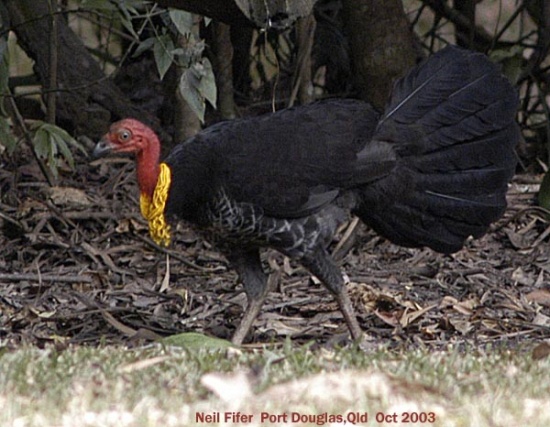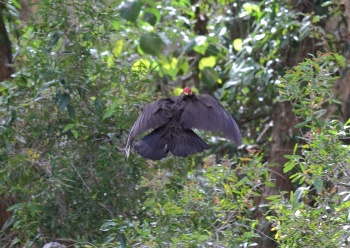m (Typo) |
(Imp sizes. Attempt to disguise copied text. picture of chick. References updated) |
||
| Line 2: | Line 2: | ||
;[[:Category:Alectura|Alectura]] lathami | ;[[:Category:Alectura|Alectura]] lathami | ||
==Identification== | ==Identification== | ||
| − | 60- | + | 60-70 cm (23½-27½ in) (almost as a domestic turkey).<br /> |
| − | Black body | + | *Black body |
| + | *Featherless red head | ||
| + | *Yellow throat wattle (pale blue in northern birds, subspecies ''purpureicollis''). | ||
| + | <br /> | ||
| + | One strange feature is the tail which is flattened vertically, opposite to most birds. | ||
| + | <br /> | ||
| + | The males' red heads and yellow wattles become much brighter during the breeding and nesting season. | ||
==Distribution== | ==Distribution== | ||
[[Image:Australian Brush-turkey 2.JPG|thumb|350px|right|Photo by {{user|Mzungu|Mzungu}}<br />Wellington Point, [[Queensland]], December 2012 ]] | [[Image:Australian Brush-turkey 2.JPG|thumb|350px|right|Photo by {{user|Mzungu|Mzungu}}<br />Wellington Point, [[Queensland]], December 2012 ]] | ||
| Line 15: | Line 21: | ||
:*Eastern [[Australia]] (Cape York Peninsula to northern [[New South Wales]]) | :*Eastern [[Australia]] (Cape York Peninsula to northern [[New South Wales]]) | ||
==Habitat== | ==Habitat== | ||
| + | [[Image:The Australian bushturkey Alectura lathami .jpg|thumb|350px|right|Chick<br />Photo by {{user|peterpeterpumpkineater|peterpeterpumpkineater}}<br />Marcoola, [[Queensland]], [[Australia]]]] | ||
Tropical rain forests and other woodland areas, including dry scrub. Very common at camp sites and picnic areas. | Tropical rain forests and other woodland areas, including dry scrub. Very common at camp sites and picnic areas. | ||
==Behaviour== | ==Behaviour== | ||
| Line 21: | Line 28: | ||
A large nesting mound is built mostly of leaflitter, at least one meter/three feet tall and 3-5 times wider. Into this are the eggs laid by sometimes several females (she may lay in more than one mound as well). Males control the temperature of the mound by adding or extracting materials, but the eggs are incubated by the heat of composting. Upon hatching, the young dig their own way out of the mound and are left to fend for themselves. | A large nesting mound is built mostly of leaflitter, at least one meter/three feet tall and 3-5 times wider. Into this are the eggs laid by sometimes several females (she may lay in more than one mound as well). Males control the temperature of the mound by adding or extracting materials, but the eggs are incubated by the heat of composting. Upon hatching, the young dig their own way out of the mound and are left to fend for themselves. | ||
====Diet==== | ====Diet==== | ||
| − | + | [[Dictionary_M-O#O|Omnivorous]], their diet consists of invertebrates, nuts, seeds, grain, roots and windfall fruits. | |
==References== | ==References== | ||
| − | #{{Ref- | + | #{{Ref-Clements6thAug16}}#Pizzey, G. & Knight, F. 1997. Birds of Australia (Collins Field Guide). HarperCollins Publishers, London. ISBN 0-00-220132-1 |
#BF Member observations | #BF Member observations | ||
| + | #Handbook of the Birds of the World Alive (retrieved December 2016) | ||
{{ref}} | {{ref}} | ||
==External Links== | ==External Links== | ||
{{GSearch|Alectura+lathami}} | {{GSearch|Alectura+lathami}} | ||
[[Category:Birds]] [[Category:Alectura]] | [[Category:Birds]] [[Category:Alectura]] | ||
Revision as of 23:11, 14 December 2016
- Alectura lathami
Identification
60-70 cm (23½-27½ in) (almost as a domestic turkey).
- Black body
- Featherless red head
- Yellow throat wattle (pale blue in northern birds, subspecies purpureicollis).
One strange feature is the tail which is flattened vertically, opposite to most birds.
The males' red heads and yellow wattles become much brighter during the breeding and nesting season.
Distribution
Australia in the coastal strip from Cape York to the southern parts of New South Wales. Also on Kangaroo Island.
Taxonomy
Subspecies
There are 2 subspecies[1]:
- A. l. purpureicollis:
- North-eastern Australia (northern Cape York Peninsula)
- A. l. lathami:
- Eastern Australia (Cape York Peninsula to northern New South Wales)
Habitat
Tropical rain forests and other woodland areas, including dry scrub. Very common at camp sites and picnic areas.
Behaviour
This species does not seem to engage in migration or nomadic behavior.
Breeding
A large nesting mound is built mostly of leaflitter, at least one meter/three feet tall and 3-5 times wider. Into this are the eggs laid by sometimes several females (she may lay in more than one mound as well). Males control the temperature of the mound by adding or extracting materials, but the eggs are incubated by the heat of composting. Upon hatching, the young dig their own way out of the mound and are left to fend for themselves.
Diet
Omnivorous, their diet consists of invertebrates, nuts, seeds, grain, roots and windfall fruits.
References
- Clements, J. F., T. S. Schulenberg, M. J. Iliff, D. Roberson, T. A. Fredericks, B. L. Sullivan, and C. L. Wood. 2016. The eBird/Clements checklist of birds of the world: v2016, with updates to August 2016. Downloaded from http://www.birds.cornell.edu/clementschecklist/download/
- Pizzey, G. & Knight, F. 1997. Birds of Australia (Collins Field Guide). HarperCollins Publishers, London. ISBN 0-00-220132-1
- BF Member observations
- Handbook of the Birds of the World Alive (retrieved December 2016)
Recommended Citation
- BirdForum Opus contributors. (2024) Australian Brushturkey. In: BirdForum, the forum for wild birds and birding. Retrieved 28 April 2024 from https://www.birdforum.net/opus/Australian_Brushturkey






